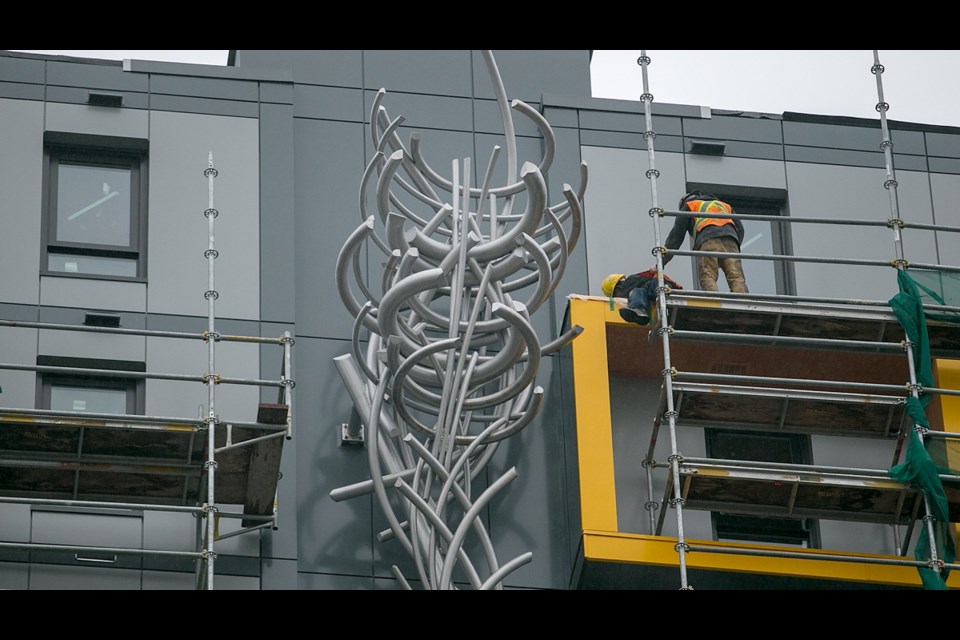The aluminum sculpture hangs high above Yates Street, as though pulled from the ground and carried aloft when the 15-storey building to which it is attached sprouted from the earth.
That’s the idea, says the man behind Victoria’s newest piece of public art. Illarion Gallant named it Tap Route, a play on a tree’s tap root, the one that anchors it and nurtures life.
That’s like the residential project itself, Gallant says. “It’s bringing people in. It’s making a community, making a fertile place for people to grow and be. That was my metaphor.”
I like the artwork. Others will hate it. Gallant is OK with that.
Oh, you have to have a thick skin, or at least be confident in your vision, when creating art for open-air display. Put your sculptures, or murals, or whatever outside for the world to see, and the world will tell you what it thinks, often at a volume and in terms rarely heard by artists whose work is shown in hushed, refined galleries. The confluence of public art and private tastes can be a messy place.
That’s particularly true of abstract, taxpayer-funded pieces. In 2003, a huge brouhaha erupted when Mowry Bowden’s $120,000 abstract sculpture Pavilion, Rock and Shell was unveiled in front of the Save-on-Foods Memorial Centre. (One letter-to-the-editor writer suggested relocating it to the airport and renaming it Cessna, Rock and Fog.)
Likewise, not everyone loved Jay Unwin’s marble Truth and Harmony when it appeared outside the Victoria police station in 1996 — “that block of cement with the bare bottoms” is how one TC reader described it.
But if some don’t like the avant-garde, others cringe at figurative pieces. In 2002, it was Buckingham Palace that deemed too Disneyish a proposal to erect outside Saanich municipal hall a $15,000 life-sized statue of Queen Elizabeth cuddling a corgi on a bench. And the Inner Harbour’s The Homecoming, a privately funded bronze sculpture of a child rushing to greet a returning sailor, was one Hallmark moment too many for some when unveiled in 2010.
“Does every piece of art on our sidewalks have to look like this?” asked a letter to the editor of The Homecoming. “It’s as if we required movie theatres to show nothing but Snow White and The Little Mermaid, or bookstores to sell just romance novels and the Little House on the Prairies series. Makes my teeth hurt.” (Critics will be comforted to know that across the Internet are scattered images of women interacting with The Homecoming, pushing a hand into the bronze child’s face while tilting forward so the sailor’s outstretched hand is cupping a breast.)
Opinions often shift over time, though. When a carved depiction of Indigenous whalers in a canoe was first installed in the lobby of the Royal B.C. Museum half a century ago, a museum consultant dismissed the $80,000 work as “tedious, inaccurate, unimaginative, confused, dead and far, far too expensive.” Another expert, brought in from the British Museum, declared: “The display turned the museum into a shoddy tourist trap. It does not resemble a whaling scene at all … . It resembles ancient Egyptians rescuing the bloated bodies of camels out of the Suez Canal.”
Yet when the canoe disappeared from the lobby a quarter- century later, a public outcry ensued.
Gallant, the creator of Tap Route, is fine with criticism of art, just as long as the critics go beyond declaring “that’s crap.”
“People don’t like it? That’s cool, but articulate it.”
He said this while standing in a hard hat and high-vis vest outside 819 Yates St., where similarly clad workers had just completed the delicate task of craning his five-storey sculpture up Chard Developments’ new building.
Unlike city-initiated projects on public land — the bridge, say, or the arena — there’s no automatic requirement to incorporate art into private developments. At the Yates Street building, however, putting $100,000 into art became part of the rezoning process. Some developers would resent that, says Gallant, but David Chard just seemed keen to commission a work that would engage passersby. “He’s cultured and he’s intellectual.”
The idea for Tap Route gave the developer pause at first, though. “He said: ‘I’m uncomfortable,’ Gallant recalled. “I said: ‘Good.’ ”
Part of the deal was that Gallant would do a bit of teaching to sheet metal students at Camosun College. (Chard is a big supporter of Camosun’s efforts to train people in the kind of trades where there is a demand.
“Welding art is something that I think is an interesting opportunity for students,” he says.) The actual fabrication of the sculpture’s aluminum components was done at Associated Sheet Metal in Central Saanich.
“I think it fits on the building very nicely,” Chard said Thursday.



